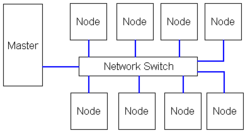Beowulf cluster: Difference between revisions
imported>Eric M Gearhart (Need to rewrite this section) |
imported>Eric M Gearhart m (just formatting) |
||
| Line 29: | Line 29: | ||
It should be noted that more than 50 percent of the machines on the Top 500 List of supercomputers | It should be noted that more than 50 percent of the machines on the Top 500 List of supercomputers | ||
<ref name="Top 500">{{cite web|url=http://top500.org|title="TOP500 Supercomputer Sites"|date=Retreived 11-April-2007}}</ref> are clusters of this sort.<ref name="The inside story of the Beowulf saga"/> | <ref name="Top 500">{{cite web|url=http://top500.org|title="TOP500 Supercomputer Sites"|date=Retreived 11-April-2007}}</ref> are clusters of this sort.<ref name="The inside story of the Beowulf saga"/> | ||
==External links== | ==External links== | ||
Revision as of 11:19, 11 April 2007

A Beowulf cluster is a group of personal computers linked together so that they act as one. This is known as parallel computing. This type of cluster is composed of a 'master' (which coordinates the processing power of the cluster) and usually many 'nodes' (computers that actually perform the calculations). The 'master' is typically a server, and "has more horsepower" than the individual nodes. The nodes in the cluster don't have to be identical, although to simplify deployment this is usually the case.
Usually the Beowulf 'nodes' are running Linux,[1] however this is not required, as both Mac OS X and FreeBSD clusters have been created.[2][3]
Beowulf Development
In early 1993, NASA scientists Donald Becker and Thomas Sterling began sketching out the details of what would become a revolutionary way to build a cheap supercomputer: link low-cost desktops together with commodity, off the shelf (COTS) hardware and combine their performance.[4]
By 1994, under the sponsorship of the "High Performance Computing & Communications for Earth & Space Sciences" (HPCC/ESS)[5] project, the Beowulf Parallel Workstation project at NASA's Goddard Space Flight Center had begun.[6] [7]
Popularity in High-Performance Computing
Today Beowulf systems are deployed worldwide as both as "cheap supercomputers" and as more traditional high-performance projects, chiefly in support of number crunching and scientific computing.
It should be noted that more than 50 percent of the machines on the Top 500 List of supercomputers [8] are clusters of this sort.[4]
External links
The Linux Beowulf HOWTO, from the Linux documentation project
References
- ↑ "Beowulf Project Overview" (Retreived 08-April-2007).
- ↑ "Mac OS X Beowulf Cluster Deployment Notes" (Retreived 08-April-2007).
- ↑ "A small Beowulf Cluster running FreeBSD" (Retreived 08-April-2007).
- ↑ 4.0 4.1 "The inside story of the Beowulf saga" (Retreived 11-April-2007).
- ↑ "High Performance Computing & Communications for Earth & Space Sciences homepage" (Retreived 11-April-2007).
- ↑ "Donald Becker's Bio at Beowulf.org" (Retreived 11-April-2007).
- ↑ "Beowulf History from beowulf.org" (Retreived 11-April-2007).
- ↑ "TOP500 Supercomputer Sites" (Retreived 11-April-2007).